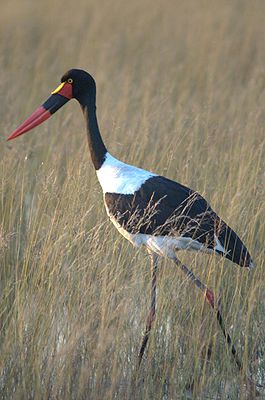Saddle stork
| Saddle stork | ||||||||||
|---|---|---|---|---|---|---|---|---|---|---|

Saddle Stork ( Ephippiorhynchus senegalensis ) |
||||||||||
| Systematics | ||||||||||
|
||||||||||
| Scientific name | ||||||||||
| Ephippiorhynchus senegalensis | ||||||||||
| ( Shaw , 1800) |
The saddle stork ( Ephippiorhynchus senegalensis ) is a walking bird that lives in Africa .
features
The slightly upwardly curved beak of the saddle stork is colored red-black-red. A piece at the top, the saddle, is colored yellow. The color of the plumage is black on the wings and on the neck and head, otherwise white. The plumage of the young birds is gray-brown, the beak black-green. The legs are gray and pink on the knees and feet. The iris of the female is golden-yellow, that of the male is brown.
The saddle stork can be 145 cm long, has a wingspan of up to 250 cm and can weigh up to 6 kg. This makes it one of the largest airborne birds in the world. The female is much smaller than the male.
Besides the rattling of the nest, the saddle stork is a silent bird.
In captivity, the animals can live up to 36 years.
Occurrence

The distribution area extends from Senegal to South Africa and Ethiopia . However, it does not occur across the board. The saddle stork needs extensive wetlands such as swamps, flood plains and silting areas in shallow lakes.
Reproduction
Each breeding pair has a mighty nest made of branches and twigs , which is always in the upper area of a tall, isolated tree and offers a clear view on all sides. Year after year the pair of saddle storks use the same eyrie, which is repaired every year during the courtship and mating season and the nest cavity is re-clad with leaves, reed stalks and clay.
The female lays two to three, occasionally four, rarely five eggs weighing around 146 g. Both parent birds take turns in the 30 to 35-day brood and also share the rearing of the young. After 70–100 days the young are fledged. The young birds reach sexual maturity at around three years of age.
food
The saddle stork feeds on small vertebrates such as fish, snakes, frogs and rodents as well as on insects, preferably grasshoppers , crabs, snails and also carrion . When searching for food, it strides around in the shallow water with its head stretched out and its beak pointing downwards and quickly stumbles for prey. He regularly dips his beak into the water to startle prey that have hidden between the plants.
behavior
Saddle storks live in pairs in fixed territories from which they drive off other conspecifics.
Duration
The saddle stork is affected by the loss of habitat, especially wetlands and their pollution, e.g. B. threatened by pesticides. Due to the large distribution area and the frequency of the species, the IUCN does not consider it to be endangered. However, the frequency of the saddle stork varies greatly from region to region. In the Republic of South Africa there are e.g. B. only 50 pairs of saddle storks, in the Bangweulu Basin in northeast Zambia only 275 individuals (status: mid-1980s).
Cultural history
|
The saddle stork was represented in the Egyptian hieroglyph " Ba " ( Gardiner list, no. G29 ), which stood for a certain aspect of the soul that was believed to be able to detach itself from the body (free soul ). Pharaoh Chaba of 3rd Dynasty used this hieroglyph as part of his name.
photos
... in the Hagenbeck Zoo .
Saddle stork in freedom ( Botswana , Africa)
Young animals in the Cottbus zoo
Saddle storks at the Guangzhou Zoo
Individual evidence
- ↑ Ephippiorhynchus senegalensis in the endangered Red List species the IUCN 2012. Posted by: BirdLife International, 2012. Accessed October 29, 2012th
Web links
- Ephippiorhynchus senegalensis onthe IUCN Red List of Threatened Species .
- Videos, photos and sound recordings about Ephippiorhynchus senegalensis in the Internet Bird Collection






